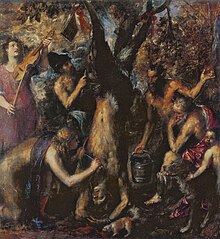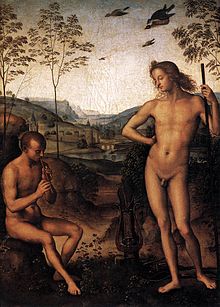Marsyas
Marsyas ( ancient Greek Μαρσύας Marsýas , Latin and German 'Mársyas'); originally god of the river of the same name, which rises near Kelainai , a flourishing city in southern Phrygia in antiquity , at the sources of the Meander . In the Greco-Roman saga a satyr (or Silenus), a semi-divine being, son of Hyagnis , companion of Cybele . Different ancient authors vary the legend, such as Herodotus (7.26) or Ovid (Metamorphoses 6.382-400).
myth
In addition to various other variants of the Marsyas myth, the following is perhaps an original one: Athena (ingenuity, wisdom) invented the double flute ( aulos ) and a certain melody after the beheading of the Gorgon Medusa and a certain melody that imitated the mortuary lament of Euryale , Medusa's sister. But when she saw her face reflected in water while playing and noticed that playing the instrument disfigured her face, she threw the flute away. Marsyas, who accompanied the frenzied and drum-beating Cybele through Phrygia , found the instrument, learned to play it and was finally so convinced of his art that he challenged Apollon to a competition. The Muses , to whom the arbitration office fell, initially saw Marsyas as the superior. However, when Apollo added the vocals to his kithar playing, it could emerge victorious. As a punishment, Apollon hung Marsyas from a spruce (the sacred tree of Cybele), the hung satyr's skin was peeled off while he was alive . The Marsyas river of the same name sprang from his blood. Pseudo-Palaephatus reports: “ I myself saw the river in Phrygia that is named after him. And the Phrygians say that the river originated from the blood of Marsyas. " Herodotus (5th century BC) knows 7.26:" In the city of Kelainai also hangs the skin of the satyr Marsyas. According to the legend, the Phrygians took Apollo from Marsyas and hung it here. “Similar to Xenophon (4th century BC), anab. 1,2,8: “ Here Apollo is said to have peeled off the skin of Marsyas after he defeated him in a competition and hung it up in the spring grotto. That is why the river is called Marsyas. "
With some probability, also in comparison with the river of the Midas myth , which has been proven to contain gold, the Marsyas was a small stream or river containing iron oxide , the red color of which was associated with blood and thus with a "divine dish" of prehistoric times. The extent of this "blood flow" could have been associated with a correspondingly large injury, as illustrated by the peeling off or flaying of the skin of animals (the punishment of flaying is not proven in ancient Greece, but was common in the ancient Orient).
For interpretation


The Marsyas myth is, presumably, a variant of the hubris allegory that was widespread in antiquity , where the demi-divine or mortal wants to rise above the divine (perfect, timeless) and is sometimes cruelly punished (turned into stone or animal, beaten with madness , dog-eared, etc.).
According to old ideas, hubris was a nymph who begat the god Pan with Zeus . Marsyas, here often equated with Pan in ancient representations, but without the attributes of God, seems to be more of a parable for the mindless instincts of man. Hubris is illustrated here using the example of art. In the ancient Greek understanding, the arts were the highest form of expression of competition ( agon ), since only they combined skill (techné) with wisdom (sophia). The muses sometimes compete themselves, and sometimes they exercise the office of judge in art. Wisdom ( Athene ) invents art, here the flute, but its exercise, i.e. the work of art, is against its (resting) being - in the parable, making work of art (poein) distorts the features of the goddess of the spirit. The desires (Marsyas) follow the desire for recognition, which is expressed in the agon . The delusion of lust that she could rise above the transitory in a work, as old as culture, falls under the merciless judgment of the muses and Apollo.
The Marsyas myth is probably not a representation against the work of art itself, but against the artist who does not make the work with humility and submission, whose work is therefore not an expression of humility. The famous beginnings of Western poetry in Homer are often interpreted in this sense: "Tell me muse"; "Sing of anger, O Goddess". The rejection of the artist's will has been expressed repeatedly since then. For example as a paradox of Michelangelo : “ I want, Lord, what I don't want. Paul Cézanne , for example, is similar : “ But if he [the artist] gets in the way, if he dares, the wretched man, to deliberately interfere in the translation process, then he only introduces his insignificance, the work becomes inferior. “And elsewhere:“ In order to paint that, the craft must then begin, but a humble craft that obeys and is ready, unconsciously, to transfer. "
The myth is also an aition for a human skin hung and exhibited in the Phrygian city of Kelainai (cf. Herodotus 7:26).
According to Wilamowitz , the myth shows the Attic disdain for the Phrygian flute and the superiority of one's own and noble kithara (Der Glaube der Hellenen, Vol. 1, Berlin 1931, p. 189, A.2). The classic representation of Myron in around 450 BC . The Athena-Marsyas group created in BC aims at exactly this connection between wisdom (Athene, Apollon, Kithara) and desire (Marsyas, flute). Flaying is thus also a symbol of catharsis , ie the earthly cover must be pained off in order to reach a higher form of knowledge. In order to spiritualize itself, the natural being has to renounce all pleasure, in Freudian terms it is a question of the painful victory of the reality principle over the pleasure principle.
Representations in art
With the help of Roman copies, in particular the marble copy from the Lateran in Rome , the original classical version of the Myronic group was reconstructed. Copies of this group of figures were also used for decorative purposes in houses and gardens. A bronze reconstruction of the Myron Group is in the Liebieghaus in Frankfurt a. M. Inside the museum is the ancient Alberici sarcophagus showing the molting of Marsyas.
The scene with the skinning of Marsyas found its reception among other things in the Renaissance by the painter Titian 1570–1576 . This motif also occurs in later art epochs. Jusepe de Ribera, for example, uses this motif several times.
Alfred Hrdlicka created a modern form of Marsyas .
literature
- Heinz J. Drügh: Marsyas. In: Maria Moog-Grünewald (Ed.): Mythenrezeption. The ancient mythology in literature, music and art from the beginnings to the present (= Der Neue Pauly . Supplements. Volume 5). Metzler, Stuttgart / Weimar 2008, ISBN 978-3-476-02032-1 , pp. 413-417.
- Dietrich Helms: From Marsyas to Küblböck. A little history and theory of musical competitions. In: Dietrich Helms, Thomas Phleps (ed.): Nobody will win. Popular music in competition (= contributions to popular music research. Volume 33). transcript, Bielefeld 2005, pp. 11-39.
- Otto Jessen : Marsyas . In: Wilhelm Heinrich Roscher (Hrsg.): Detailed lexicon of Greek and Roman mythology . Volume 2.2, Leipzig 1897, Col. 2439-2460 ( digitized version ).
- Klaus Junker : The Athena Marsyas group of the Myron. In: Yearbook of the German Archaeological Institute. Volume 117, 2003, pp. 127-184.
- Andreas F. Kelletat: The undamaged Marsyas. In: Dietmar Albrecht et al. (Ed.): Unverschmerzt. Johannes Bobrowski: Life and Work. Meidenbauer, Munich 2004, ISBN 3-89975-511-1 , pp. 171-185.
- Katia Marano: Apollo and Marsyas. Iconological studies on a myth in the Italian Renaissance (= European university publications. Series 28 [Art History], Volume 324). Lang, Frankfurt am Main 1998, ISBN 3-631-32919-9 (also dissertation, University of Marburg 1993).
- Luise Seemann: Marsyas and Moira. The layers of a Greek myth. diagonal, Marburg 2006, ISBN 3-927165-95-6 .
- Luise Seemann: On the interpretation of the Athena Marsyas group of the Myron. In: Boreas. Münster contributions to archeology. Volume 32, 2009, pp. 1-18.
- Ursula Renner, Manfred Schneider (Ed.): Moulting. Readings of the Marsyas myth. Fink, Munich 2006, ISBN 3-7705-4014-X .



